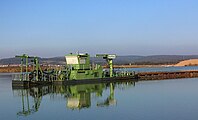Suction dredger
Suction dredger refers to three different types of heavy machines from civil engineering and hydraulic engineering for the extraction of mineral building materials and mineral raw materials .
technology
Suction excavator with drive
It is a self-propelled dredger for use in ports, on waterways or at sea, which with the help of a milling head ( cutter dredger ) or a towing head ( hopper dredger ) loosens the sediment on the river bed and sucks it on board through a suction line. The water content is separated off and deposited back into the water; the solid components of the suction material are either filled into a barge or into the hold of the ship itself (hold suction dredger) and transported away or pumped directly to nearby washing areas .
Suction excavator without drive
For sand and gravel extraction in gravel pits , a pontoon with suction device for gravel or sand is used, which is sucked off under water at the bottom of the water. The water content is separated back into the water, the solid components of the suction material are transported to land on a conveyor belt and stored there until they are removed.
- floating suction dredger
Suction dredger "Baltic Sea" with full loading space on the Lower Elbe
Suction dredger on the Suez Canal
Suction excavator (construction machine on land)
A suction excavator is a heavy construction machine weighing between 18 and 40 tons. It is like an oversized vacuum cleaner and removes various materials from the floor, e.g. B. earth, clay, gravel, crushed stone, water and mud.
Suction excavators are used wherever a high risk of damage prohibits the use of hydraulic excavation technology or the surrounding conditions do not allow it.
Possible applications are, for example, pipe and armature replacement, pipe bursts, renovation and relocation of gas, water, cable, district heating and disposal lines, road breaks, maintenance and repairs in the track area, the use of soil displacement rockets , the removal of environmental damage, the replacement contaminated soil in the root area of trees, demolition work, suction of gravel from flat roofs, cleaning of street gullies and gullies in connection with horizontal drilling rigs, leaf suction and special cases.
Suction excavators allow short deployments, rapid, damage-free excavation as well as low traffic and environmental pollution.
Working principle

A blower generates an air flow of up to 44,000 m³ / h and a maximum negative pressure of 55,000 Pa . The suction hose can be moved hydraulically in three dimensions via its carrier. In the area of the suction head, the material is carried away by the air flow. All media, solid particles up to a size of 250 mm can be suctioned. Due to the calming and rotation of the air, all essential particles are deposited in the collecting space. The air flow is further cleaned and dried via separation chambers. The position of the collecting container determines the axle load of the vehicle. The last dust is absorbed by the ultra-fine filter unit. The cleaned air is expelled upwards over a large area via a sound insulation unit. The fine filters are cleaned with compressed air. When tilting, not only the collection chamber but also the separation chambers and the fine filters are emptied. All body functions are remote controlled via cable or radio .
See also
literature
- V. Patzold, G. Gruhn, C. Drebenstedt: The wet mining - exploration, extraction, processing, evaluation . Springer, Berlin / Heidelberg / New York 2008, ISBN 978-3-540-49692-2 .
- Pictures and reports from operations of a suction excavator: http://www.saugbagger.org/
Web links
Individual evidence
- ↑ Versatility - Nothing is impossible. Pfaffinger Group, accessed on August 31, 2019 (German).
- ↑ Our suction excavator. Freund suction dredger service, accessed August 31, 2019 .



